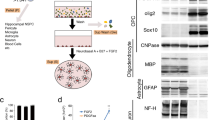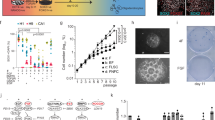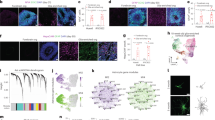Abstract
We have been studying a population of bipotential glial progenitor cells in the perinatal rat optic nerve and brain in an attempt to understand how cells choose between alternative fates in the developing mammalian central nervous system (CNS). This cell population gives rise initially to oligodendrocytes and then to type-2 astrocytes1, both of which apparently collaborate in sheathing axons in the CNS2,3. In vitro studies suggest that oligodendrocyte differentiation is the constitutive pathway of development for the oligodendrocyte-type-2-astrocyte (O-2A) progenitor cell4,5, whereas type-2 astrocyte differentiation depends on a specific inducing protein6. This protein is present in the developing optic nerve when type-2 astrocytes are differentiating and can induce O-2A progenitor cells in vitro to express glial fibrillary acidic protein (GFAP)6, a marker of astrocyte differentiation7. Here we show that the type-2-astrocyte-inducing protein is similar or identical to ciliary neutrotrophic factor (CNTF)8,9, which promotes the survival of some types of peripheral neurons in vitro8, including ciliary ganglion neurons8,10. This suggests that CNTF, in addition to its effect on neurons, may be responsible for triggering type-2 astrocyte differentiation in the developing CNS.
This is a preview of subscription content, access via your institution
Access options
Subscribe to this journal
Receive 51 print issues and online access
$199.00 per year
only $3.90 per issue
Buy this article
- Purchase on Springer Link
- Instant access to full article PDF
Prices may be subject to local taxes which are calculated during checkout
Similar content being viewed by others
References
Raff, M. C., Miller, R. & Noble, M. Nature 303, 390–396 (1983).
ffrench-Constant, C. & Raff, M. C. Nature 323, 335–338 (1986).
Miller, R. H., ffrench-Constant, C. & Raff, M. C. A. Rev. Neurosci. (in the press).
Raff, M. C., Abney, E. R. & Fok-Seang, J. Cell 42, 61–69 (1985).
Temple, S. & Raff, M. C. Nature 313, 223–225 (1985).
Hughes, S. M. & Raff, M. C. Development 101, 157–167 (1987).
Bignami, A., Eng, L. F., Dahl, D. & Uyeda, C. T. Brain Res. 43, 429–435 (1972).
Barbin, G., Manthorpe, M. & Varon, S. J. Neurochem. 43, 1468–1478 (1984).
Manthorpe, M., Skaper, S. D., Williams, L. R. & Varon, S. Brain Res. 367, 282–286 (1986).
Helfand, S., Smith, G. A. & Wessells, N. K. Devl Biol. 50, 541–547 (1976).
Greene, L. A. & Shooter, E. M. A. Rev. Neurosci. 3, 353–402 (1980).
Levi-Montalcini, R. Science 237, 1154–1162 (1987).
Barde, Y.-A., Edgar, D. & Thoenen, H. EMBO J. 1, 549–553 (1982).
Rudge, J. S., Davis, G. E., Manthorpe, M. & Varon, S. Devi Brain Res. 32, 103–110 (1987).
Richardson, W. D., Pringle, N., Mosley, M., Westermark, B. & Dubois-Dalcq, M. Cell 53, 309–319 (1988).
Miller, R. H., David, S., Patel, R., Abney, E. R. & Raff, M. C. Devl Biol. 111, 35–41 (1985).
Lillien, L. E., Sendtner, M., Rohrer, H., Hughes, S. M. & Raff, M. C. Neuron (in the press).
Noble, M. & Murray, K. EMBO J. 3, 2243–2247 (1984).
Noble, M., Murray, K., Stroobant, P., Waterfield, M. & Riddle, P. Nature 333, 559–561 (1988).
Raff, M. C., Lillien, L. E., Richardson, W., Burnes, J. & Noble, M. Nature 333, 562–565 (1988).
Rudge, J. S., Manthorpe, M. & Varon, S. Devl Brain Res. 19, 161–172 (1985).
Williams, B. P., Abney, E. R. & Raff, M. C. Devl Biol. 112, 126–134 (1985).
Rohrer, H., Sendtner, M. & Ernsberger, U. Biol. Chem. Hoppe Seyler 368, 1290–1291 (1987).
Bottenstein, J. E. & Sato, G. H. Proc. natn. Acad. Sci. U.S.A. 76, 514–517 (1979).
Eisenbarth, G. S., Walsh, F. S. & Nirenberg, M. Proc. natn. Acad. Sci. U.S.A. 76, 4913–4917 (1979).
Pruss, R. Nature 280, 688–690 (1979).
Temple, S. & Raff, M. C. Cell 44, 773–779 (1986).
Harper, G. P. et al. Neuroscience 8, 375–387 (1983).
Laemmli, U. K. & Favre, M. J. molec. Biol. 80, 577–599 (1974).
Oakley, B. R., Kirsch, D. R. & Morris, N. R. Analyt. Biochem. 105, 361–363 (1980).
Lemke, G. E. & Brockes, J. P. J. Neurosci. 4, 75–83 (1984).
Author information
Authors and Affiliations
Rights and permissions
About this article
Cite this article
Hughes, S., Lillien, L., Raff, M. et al. Ciliary neurotrophic factor induces type-2 astrocyte differentiation in culture. Nature 335, 70–73 (1988). https://doi.org/10.1038/335070a0
Received:
Accepted:
Published:
Issue Date:
DOI: https://doi.org/10.1038/335070a0
This article is cited by
-
Neurotrophic Factors Mediated Activation of Astrocytes Ameliorate Memory Loss by Amyloid Clearance after Transplantation of Lineage Negative Stem Cells
Molecular Neurobiology (2019)
-
Hypomethylation of CNTFRα is associated with proliferation and poor prognosis in lower grade gliomas
Scientific Reports (2017)
-
Rapid and robust generation of functional oligodendrocyte progenitor cells from epiblast stem cells
Nature Methods (2011)
-
Ciliary neurotrophic factor: a survival and differentiation inducer in human retinal progenitors
In Vitro Cellular & Developmental Biology - Animal (2010)
-
Failure of Schwann cells as supporting cells for adult neural progenitor cell grafts in the acutely injured spinal cord
Cell and Tissue Research (2006)
Comments
By submitting a comment you agree to abide by our Terms and Community Guidelines. If you find something abusive or that does not comply with our terms or guidelines please flag it as inappropriate.



